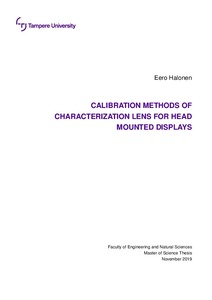Calibration Methods of Characterization Lens for Head Mounted Displays
Halonen, Eero (2019)
Halonen, Eero
2019
Teknis-luonnontieteellinen DI-ohjelma - Degree Programme in Science and Engineering
Tekniikan ja luonnontieteiden tiedekunta - Faculty of Engineering and Natural Sciences
This publication is copyrighted. You may download, display and print it for Your own personal use. Commercial use is prohibited.
Hyväksymispäivämäärä
2019-11-27
Julkaisun pysyvä osoite on
https://urn.fi/URN:NBN:fi:tuni-201911266313
https://urn.fi/URN:NBN:fi:tuni-201911266313
Tiivistelmä
This thesis concerns the calibration, characterization and utilization of the HMD Eye, OptoFidelity’s eye-mimicking optical camera system designed for the HMD IQ, a complete test station for near eye displays which are implemented in virtual and augmented reality systems. Its optical architecture provides a 120 degree field of view with high imaging performance and linear radial distortion, ideal for analysis of all possible object fields. HMD Eye has an external, mechanical entrance pupil that is of the same size as the human entrance pupil.
Spatial frequency response (the modulation transfer function) has been used to develop sensor focus calibration methods and automation system plans. Geometrical distortion and its relation to the angular mapping function and imaging quality of the system are also considered.
The nature of the user interface for human eyes, called the eyebox, and the optical properties of head mounted displays are reviewed. Head mounted displays consist usually of two near eye displays amongst other components, such as position tracking units. The HMD Eye enables looking inside the device from the eyebox and collecting optical signals (i.e. the virtual image) from the complete field of view of the device under test with a single image.
The HMD Eye under inspection in this thesis is one of the ’zero’ batch, i.e. a test unit. The outcome of the calibration was that the HMD Eye unit in this thesis is focused to 1.6 m with an approximate error margin of ±10 cm. The drop of contrast reaches 50% approximately at angular frequency of 11 cycles/degree which is about 40% of the simulated values, prompting improvements in the mechanical design. Geometrical distortion results show that radial distortion is very linear (maximum error of 1%) and that tangential distortion has a diminishable effect (0.04 degrees of azimuth deviation at most) within the measurement region.
Spatial frequency response (the modulation transfer function) has been used to develop sensor focus calibration methods and automation system plans. Geometrical distortion and its relation to the angular mapping function and imaging quality of the system are also considered.
The nature of the user interface for human eyes, called the eyebox, and the optical properties of head mounted displays are reviewed. Head mounted displays consist usually of two near eye displays amongst other components, such as position tracking units. The HMD Eye enables looking inside the device from the eyebox and collecting optical signals (i.e. the virtual image) from the complete field of view of the device under test with a single image.
The HMD Eye under inspection in this thesis is one of the ’zero’ batch, i.e. a test unit. The outcome of the calibration was that the HMD Eye unit in this thesis is focused to 1.6 m with an approximate error margin of ±10 cm. The drop of contrast reaches 50% approximately at angular frequency of 11 cycles/degree which is about 40% of the simulated values, prompting improvements in the mechanical design. Geometrical distortion results show that radial distortion is very linear (maximum error of 1%) and that tangential distortion has a diminishable effect (0.04 degrees of azimuth deviation at most) within the measurement region.
